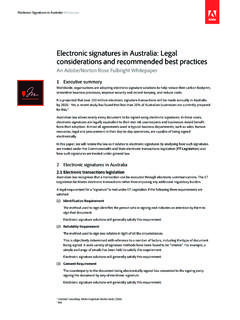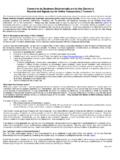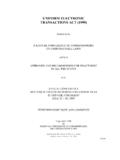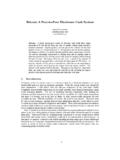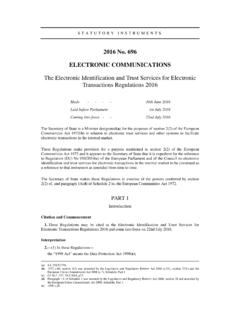Transcription of ESIGN Act: a well-established electronic signatures …
1 Adobe Sign ESIGN Act: A well - established Law enabling business Transformation Today. A guide to electronic signatures in the United States CONTENTS. for corporate counsels and compliance officers 2 ESIGN Act makes e-signa- tures legal. On June 30, 2000, President Bill Clinton signed the electronic signatures in Global and National Commerce Act ( ESIGN Act) into law without a pen. 2 E-signature solution Instead, he used an electronic signature. This ground-breaking law addresses selection is key to meeting e- signatures as well as electronic records, both of which are commonly used industry requirements. in commerce today. An e-signature was granted the same status as a written 3 C. ourt rulings focus on signature under the terms of this legislation; however, it is important to note intent to be bound and that simply placing a symbol on a document does not, in and of itself, create processes used.
2 An enforceable contract. Those who are concerned about the question of 5 E- signatures accelerate key legality must be well informed about the various requirements associated business processes. with the use of e- signatures . For most, the first and foremost question may 5 Adobe Sign is the trusted be, Are e- signatures legal? solution used by many of The simple answer is, yes, e- signatures are legal. This paper discusses several the Fortune 1000. factors relating to the legality of e- signatures in various applications and 6 Without a fully digital among different industries, with their associated regulatory environments. business , the greatest risk is It also explores the benefits of adopting a digital document solution that being left behind. enables real-time signatures . When used along with sound and consistent best practices, the optimal solution can not only create an enforceable contract, but also improve document creation, storage, retrieval, and audit trails.
3 E- signatures are fast becoming an integral part of our business landscape. Leading companies today, even in the most conservative and regulated industries such as financial services and healthcare, are rapidly adopting e- signatures to accelerate key business processes. For example, a leading healthcare company estimates that by using Adobe Sign, they decreased transaction costs from US$16 to US$ These cost-saving benefits, in addition to the improved ease and efficiency of transacting business , will undoubtedly fuel the continued growth of e- signatures . September 2017 | Adobe Sign ESIGN Act White Paper ESIGN Act makes e- signatures legal. The ESIGN Act of 2000 addresses electronic signatures as well as electronic records, both of which are commonly used in commerce today. Due to federal preemption, the ESIGN Act allows electronic signatures in all 50 states when federal law applies.
4 Where federal law does not apply, every state has an electronic signature law, most following the Uniform electronic Transactions Act (UETA). The ESIGN Act: Satisfies most statutes, that require handwritten signatures on documents Allows the contract to be used as evidence in a court of law as long as surrounding processes are well designed and implemented and the usual elements of a contract exist Prevents denial of legal effect, validity or enforceability of an electronically signed document solely because it is in electronic form According to the ESIGN Act, an e-signature is defined as an electronic sound, symbol, process attached to or logically associated with a contract or other record and executed or adopted by a person with the intent to sign the record and be legally bound. The key takeaway for purposes of contract enforcement is that the electronic sound, symbol, or process must be both associated with a contract or other document and adopted by the signatory, by some act, with the intent to be bound.
5 E-signature solution selection is key to meeting industry requirements. The broad nature of the ESIGN Act created an opportunity for regulators in various industries to make specific rules pertaining to the use of e- signatures . The ESIGN Act provides that both federal and regulatory agencies have the authority to interpret and apply the law in the context of their industries. Understanding the implications of e-signature use in a specific industry depends upon consideration of the reason the document was created. If the document is being generated for business , consumer, or commercial transactions, the ESIGN Act generally supersedes any regulatory agency's preexisting requirement that a record be kept on paper. However, if it is being created principally for governmental requirements not related to commercial transactions, the ESIGN Act may not apply. The use of electronic signatures may satisfy the requisite regulatory compliance in your industry by providing the authentication, authorization, accountability, audit, and security needed to follow your industry's particular laws.
6 The following table offers a summary of several major industry regulations coupled with the important features of a robust e-signature solution relating to those regulations. September 2017 | Adobe Sign ESIGN Act White Paper Industry regulation Overview of regulation What to look for in an e-signature solution Sarbanes-Oxley Act (SOX) SOX requires that publicly held corporations establish Solution should include robust and comprehensive security verifiable security controls to protect against disclosure safeguards such as infrastructure security and data security, of confidential data and carefully track personnel data to including application-level encryption using Secure Sockets detect fraud-related tampering. Layer (SSL) and 256-bit Advanced Encryption Standard (AES) encryption, to safeguard the confidential information in an electronic document. Gramm-Leach-Bliley Act GLBA is intended to protect consumers' privacy and The technology must provide for the safety of any personal (GLBA) provide security for consumer personal information, information captured, clearly explain notification and opt-out requiring notification and opt-out procedures and procedures to the consumer, and strictly limit reuse or limiting the reuse or marketing of consumer personal marketing of a consumer's personal information.
7 Information. Dodd-Frank Act (DFA) DFA created the Consumer Financial Protection Bureau The solution must provide for active consent of the (CFPB), a council designed to oversee financial signatory prior to applying the e-signature to the document. institutions and reform securitization. E- signatures comply provided that they adhere to the consent requirements of the federal ESIGN Act. Federal Deposit Insurance FDIC regulations relating to electronic filings and The solution should provide a typed form appearance as Corporation (FDIC) signatures require a signature to appear in typed form well as maintain an electronic copy of the physical signature and require an electronic copy of the physical signature for any document executed with an electronic signature. for anything electronically signed. Health Insurance HIPAA places stringent requirements on healthcare Companies must work only with HIPAA-compliant service Portability and providers (also called Covered Entities ) to protect providers and have a business Associate Agreement (BAA) in Accountability Act of 1996 sensitive health information.
8 Place with those providers. The solution must support HIPAA's (HIPAA) stringent privacy and security requirements to protect sensitive data, and the company's BAA must meet all HIPAA. requirements. Internal Revenue Service Currently, the use of e- signatures on IRS forms is The solution must show that the electronic form of signature (IRS) approved on an ad hoc basis. According to that is adopted by the signatory with the intent to be bound Announcement 2013-8, the IRS requires that signatures is attached to the record being signed, authenticated, and meet five core requirements that align precisely with the properly preserved and stored. ESIGN Act. McCarran-Ferguson Act The ESIGN Act expressly states that it applies to the The solution needs to comply with the ESIGN Act such that (Public Law 15) business of insurance to comply with the McCarran- insurance agents can meet the requirement that an action Ferguson Act.
9 The ESIGN Act also includes a specific be legally attributable to a person intending to be bound. provision that relieves insurance agents and brokers Simple compliance with the Uniform electronic Transactions from liability under certain conditions. Act (UETA) does not achieve this industry best practice. Court rulings focus on intent to be bound and processes used. The courts are catching up to the reality of e-signature technology in the modern business climate. The main issues that result in legal conflicts do not tend to arise around the technicalities associated with an e-signature but rather with the various elements of contract formation, that is, the facts surrounding creation of the contract. So, processes relating to capture, security, storage, and retention are important. For example, the New York Supreme Court addressed whether precise adherence to the definition of an e-signature is required to create a valid agreement.
10 In Forcelli v Gelco (2013) 109 244, a case involving settlement negotiations via email, the court concluded that a farewell statement at the end of the email was a signed and subscribed signature even though it did not technically constitute an e-signature according to statute. Evidence of a clear intent to be bound is important. Courts generally require evidence of an awareness of the terms of the contract and an act that exhibits assent or intent to be bound prior to signing a document or using a service, like clicking an I agree button. However, some courts do look at the circumstances surrounding the transaction for other indications of assent and have held that a contract is enforceable even without such an overt indication. September 2017 | Adobe Sign ESIGN Act White Paper Additional important topics covered by the courts are evidentiary issues such as preservation and admissibility of electronically stored information (ESI).


